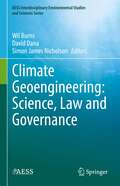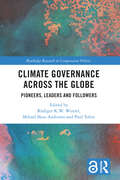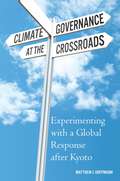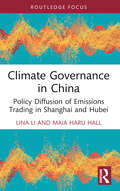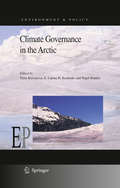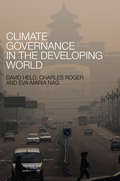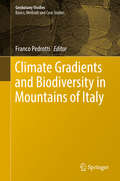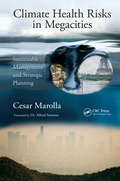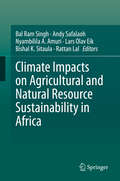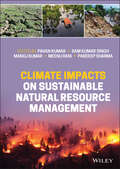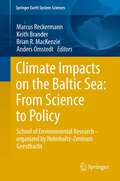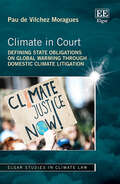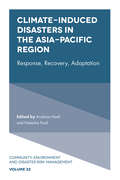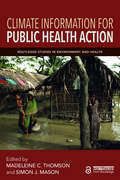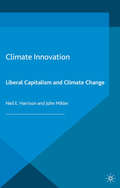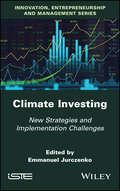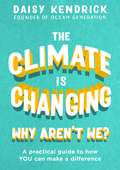- Table View
- List View
Climate Geoengineering: Science, Law and Governance (AESS Interdisciplinary Environmental Studies and Sciences Series)
by Wil Burns David Dana Simon James NicholsonThe sobering reality of the disconnect between the resolve of the world community to effectively address climate change, and what actually needs to be done, has led to increasing impetus for consideration of a suite of approaches collectively known as “climate geoengineering,” or “climate engineering.” Indeed, the feckless response of the world community to climate change has transformed climate geoengineering from a fringe concept to a potentially mainstream policy option within the past decade. This volume will explore scientific, political and legal issues associated with the emerging field of climate geoengineering. The volume encompasses perspectives on both of the major categories of climate geoengineering approaches, carbon dioxide removal and solar radiation management.
Climate Governance across the Globe: Pioneers, Leaders and Followers (Routledge Research in Comparative Politics)
by Rüdiger K.W. Wurzel, Mikael Skou Andersen and Paul TobinThis book takes an innovative approach to studying international climate governance by providing a critical analysis of climate leadership, pioneership and followership across the globe.The volume assesses the interactions between climate leaders, pioneers and followers, across multilevel and/or polycentric climate governance contexts. Examining the state and sub-state levels in both the Global South and Global North, as well as regional, supranational EU and international climate governance levels, the authors explore 16 countries across Asia, Australasia, Europe, and Central and North America, plus the European Union. Each chapter employs a comprehensive and consistent framework for analyzing leadership and pioneership, as well as followership. The findings provide new insights into the strategies and actions of sub-state, state-level, and supranational leaders and pioneers.This book will be of key interest to scholars, students and practitioners in environmental politics and climate change governance, as well as those interested in political elites, EU studies and, more broadly, comparative politics and international relations.The Open Access version of this book, available at www.taylorfrancis.com, has been made available under a Creative Commons Attribution-Non Commercial-No Derivatives (CC-BY-NC-ND) 4.0 license.
Climate Governance across the Globe: Pioneers, Leaders and Followers (Routledge Research in Comparative Politics)
by Rüdiger K. W. Wurzel Mikael Skou Andersen Paul TobinThis book takes an innovative approach to studying international climate governance by providing a critical analysis of climate leadership, pioneership and followership across the globe.The volume assesses the interactions between climate leaders, pioneers and followers, across multilevel and/or polycentric climate governance contexts. Examining the state and sub-state levels in both the Global South and Global North, as well as regional, supranational EU and international climate governance levels, the authors explore 16 countries across Asia, Australasia, Europe, and Central and North America, plus the European Union. Each chapter employs a comprehensive and consistent framework for analyzing leadership and pioneership, as well as followership. The findings provide new insights into the strategies and actions of sub-state, state-level, and supranational leaders and pioneers.This book will be of key interest to scholars, students and practitioners in environmental politics and climate change governance, as well as those interested in political elites, EU studies and, more broadly, comparative politics and international relations.The Open Access version of this book, available at www.taylorfrancis.com, has been made available under a Creative Commons Attribution-Non Commercial-No Derivatives (CC-BY-NC-ND) 4.0 license.
Climate Governance at the Crossroads: Experimenting with a Global Response after Kyoto
by Matthew J HoffmannThe global response to climate change has reached a critical juncture. Since the 1992 signing of the United Nations Framework Convention on Climate Change, the nations of the world have attempted to address climate change through large-scale multilateral treaty-making. These efforts have been heroic, but disappointing. As evidence for the quickening pace of climate change mounts, the treaty-making process has sputtered, and many are now skeptical about the prospect of an effective global response. Yet global treaty-making is not the only way that climate change can be addressed or, indeed, is being addressed. In the last decade myriad initiatives have emerged across the globe independently from, or only loosely connected to, the "official" UN-sponsored negotiations and treaties. In the face of stalemate in the formal negotiations, the world is experimenting with alternate means of responding to climate change. Climate Governance at the Crossroads chronicles these innovations--how cities, provinces and states, citizen groups, and corporations around the globe are addressing the causes and symptoms of global warming. The center of gravity in the global response to climate change is shifting from the multilateral treaty-making process to the diverse activities found beyond the negotiating halls. These innovations are pushing the envelope of climate action and demonstrating what is possible, and they provide hope that the world will respond effectively to the climate crisis. In introducing climate governance "experiments" and examining the development and functioning of this new world of climate policy-making, this book provides an exciting new perspective on the politics of climate change and the means to understand and influence how the global response to climate change will unfold in the coming years.
Climate Governance in China: Policy Diffusion of Emissions Trading in Shanghai and Hubei (Routledge Focus on Environment and Sustainability)
by Lina Li Maia Haru HallThis book explores how and why innovative climate policies spread across subnational regions and between governance levels in China. Despite the significance of emerging economies in a pathway to a zero-carbon future, research to date on China’s transformation governance remains limited. Drawing on a theoretical framework for policy diffusion and based on extensive data from expert interviews with Chinese decisionmakers and policy practitioners, Lina Li and Maia Haru Hall focus on the policy of emissions trading systems (ETS) and two key case studies: Shanghai and Hubei. The authors examine the role of the national government and how much freedom the subnational regions have in developing ETS policy, as well as pinpointing key actors and the role of policy and knowledge diffusion mechanisms. Overall, this book sheds light on the competition between China and the West in the transition to climate-friendly societies and economies, highlighting opportunities for cooperation between them. This book will be of great interest to students and scholars of environmental politics and policy, climate change, urban studies, and Chinese studies more broadly.
Climate Governance in China: Policy Diffusion of Emissions Trading in Shanghai and Hubei (Routledge Focus on Environment and Sustainability)
by Lina Li Maia Haru HallThis book explores how and why innovative climate policies spread across subnational regions and between governance levels in China. Despite the significance of emerging economies in a pathway to a zero-carbon future, research to date on China’s transformation governance remains limited. Drawing on a theoretical framework for policy diffusion and based on extensive data from expert interviews with Chinese decisionmakers and policy practitioners, Lina Li and Maia Haru Hall focus on the policy of emissions trading systems (ETS) and two key case studies: Shanghai and Hubei. The authors examine the role of the national government and how much freedom the subnational regions have in developing ETS policy, as well as pinpointing key actors and the role of policy and knowledge diffusion mechanisms. Overall, this book sheds light on the competition between China and the West in the transition to climate-friendly societies and economies, highlighting opportunities for cooperation between them. This book will be of great interest to students and scholars of environmental politics and policy, climate change, urban studies, and Chinese studies more broadly.
Climate Governance in the Arctic (Environment & Policy #50)
by Timo Koivurova E. Carina H. Keskitalo Nigel BankesClimate change is affecting the Arctic environment and ecosystems at an accelerating speed, twice the rate of the global average. This is opening the Arctic to transportation and resource development and creating serious challenges for local communities and indigenous peoples. Climate Governance in the Arctic considers two aspects of climate change from an institutional perspective. It focuses on how relevant regimes, institutions and governance systems support mitigation of climate change. It also examines the extent to which the varying governance arrangements in the Arctic support adaptation and the development of adaptation processes for the region. The book’s focus on Arctic governance offers unique insights within climate change mitigation and adaptation research.
Climate Governance in the Developing World
by David Held Charles Roger Eva-Maria NagSince 2009, a diverse group of developing states that includes China, Brazil, Ethiopia and Costa Rica has been advancing unprecedented pledges to mitigate greenhouse gas emissions, offering new, unexpected signs of climate leadership. Some scholars have gone so far as to argue that these targets are now even more ambitious than those put forward by their wealthier counterparts. But what really lies behind these new pledges? What actions are being taken to meet them? And what stumbling blocks lie in the way of their realization? In this book, an international group of scholars seeks to address these questions by analyzing the experiences of twelve states from across Asia, the Americas and Africa. The authors map the evolution of climate policies in each country and examine the complex array of actors, interests, institutions and ideas that has shaped their approaches. Offering the most comprehensive analysis thus far of the unique challenges that developing countries face in the domain of climate change, Climate Governance in the Developing World reveals the political, economic and environmental realities that underpin the pledges made by developing states, and which together determine the chances of success and failure.
Climate Governance in the Developing World
by David Held Charles Roger Eva-Maria NagSince 2009, a diverse group of developing states that includes China, Brazil, Ethiopia and Costa Rica has been advancing unprecedented pledges to mitigate greenhouse gas emissions, offering new, unexpected signs of climate leadership. Some scholars have gone so far as to argue that these targets are now even more ambitious than those put forward by their wealthier counterparts. But what really lies behind these new pledges? What actions are being taken to meet them? And what stumbling blocks lie in the way of their realization? In this book, an international group of scholars seeks to address these questions by analyzing the experiences of twelve states from across Asia, the Americas and Africa. The authors map the evolution of climate policies in each country and examine the complex array of actors, interests, institutions and ideas that has shaped their approaches. Offering the most comprehensive analysis thus far of the unique challenges that developing countries face in the domain of climate change, Climate Governance in the Developing World reveals the political, economic and environmental realities that underpin the pledges made by developing states, and which together determine the chances of success and failure.
Climate Gradients and Biodiversity in Mountains of Italy (Geobotany Studies)
by Franco PedrottiThis volume gathers case studies on plant diversity from selected, representative mountain systems of Italy (Mediterranean and temperate zones), while also addressing the biodiversity of avian fauna. For the Alps, Wilhalm and Prosser examine the species biodiversity (also with the help of highly detailed location maps) of the sector of the central Alps that corresponds to the basin of the Adige, including some nearby valleys, between the watershed to the north and the Prealps to the south (Alto Adige and Trentino). In turn, Pedrotti investigates the vegetation series of the same territory in relation to the three climatic sectors identified: prealpine, alpine and endoalpine. Aleffi then explores the relationships between the distribution of a number of species of bryophytes and the main mesoclimatic gradients along a transect through the Valle dell’ Adige between 46°40'N and 45°42'N. Lastly, Siniscalco studies the ways in which alien species are now invading the western Alps, which to date have remained largely unaffected by this phenomenon, unlike the plains and hills. For the Apennines, Ferrari studies the tree line and the biodiversity of the vegetation of the northern Apennines; for the mountains of Sicily, Bazan conducts a diachronic analysis of the beech forests of the Monti Nebrodi. The contribution by Venanzoni interprets the chorology of associations of the Magnocaricetalia order throughout Italy, relating it to the climatic and geographic gradients. He describes a total of 55 associations, reporting on the distribution in the temperate zone (differentiating between the alpine and continental) and the Mediterranean zone for each of them. Cianfaglione presents the Signal Project Italian site. This project investigates the effects of extreme weather events on secondary grassland and the role of selected alien species, mowing, biodiversity, productivity and functional traits, in Italy and along a European gradient. For the Marches Region, Forconi describes the biodiversity of the avian fauna in relation to the altitudinal gradient and the potential vegetation.
Climate Health Risks in Megacities: Sustainable Management and Strategic Planning
by Cesar MarollaClimate Health Risks in Megacities: Sustainable Management and Strategic Planning courageously confronts the immense challenges of alleviating climate change and takes the initiative to layout an agenda that calls for action in the rapidly changing landscape of our global climate. This guide provides a constructive methodology for developing and implementing risk management and operational continuity management systems to climate change effects on urban populations. It addresses key issues such as physical location, proper sanitation, food security and vector-borne diseases against the backdrop of climate change, and then model its effect on the urban dwellers. The author also reveals the benefits of implementing a unique risk management approach to combat global threats and focuses on building urban resilience in the face of disasters. Prepared with a comprehensive and forward-thinking style, this book draws on indispensable case studies in key megacities like New York, Los Angeles, Beijing, Rio de Janeiro, London, Mumbai, and Lagos, and links researchers, scientists, city’s mayors, environmentalists, policy-makers and world leaders from central areas to review, reflect, and expound on future directions.
Climate Health Risks in Megacities: Sustainable Management and Strategic Planning
by Cesar MarollaClimate Health Risks in Megacities: Sustainable Management and Strategic Planning courageously confronts the immense challenges of alleviating climate change and takes the initiative to layout an agenda that calls for action in the rapidly changing landscape of our global climate. This guide provides a constructive methodology for developing and implementing risk management and operational continuity management systems to climate change effects on urban populations. It addresses key issues such as physical location, proper sanitation, food security and vector-borne diseases against the backdrop of climate change, and then model its effect on the urban dwellers. The author also reveals the benefits of implementing a unique risk management approach to combat global threats and focuses on building urban resilience in the face of disasters. Prepared with a comprehensive and forward-thinking style, this book draws on indispensable case studies in key megacities like New York, Los Angeles, Beijing, Rio de Janeiro, London, Mumbai, and Lagos, and links researchers, scientists, city’s mayors, environmentalists, policy-makers and world leaders from central areas to review, reflect, and expound on future directions.
Climate Impacts on Agricultural and Natural Resource Sustainability in Africa
by Bal Ram Singh Andy Safalaoh Nyambilila A. Amuri Lars Olav Eik Bishal K. Sitaula Rattan LalThis book discusses knowledge-based sustainable agro-ecological and natural resource management systems and best practices for sustained agricultural productivity and ecosystem resilience for better livelihoods under a changing climate. With a focus on agriculture in Africa, the book assesses innovative technologies for use on smallholder farms, and addresses some of the key Sustainable Development Goals to guide innovative responses and enhanced adaptation methods for coping with climate change.Contributions are based on 'Capacity Building for Managing Climate Change in Malawi' (CABMACC), a five-year program with an overall goal to improve livelihoods and food security through innovative responses and enhanced capacity of adaptation to climate change. Readers will discover more about sustainable crop production, climate smart agriculture, on-farm energy supply from biogas and the potential of soil carbon sequestration in crop-livestock systems.
Climate Impacts on Sustainable Natural Resource Management
by Pavan Kumar Ram Kumar Singh Manoj Kumar Meenu Rani Pardeep SharmaCLIMATE IMPACTS ON SUSTAINABLE NATURAL RESOURCE MANAGEMENT Climate change has emerged as one of the predominant global concerns of the 21st century. Statistics show that the average surface temperature of the Earth has increased by about 1.18°C since the late 19th century and the sea levels are rising due to the melting of glaciers. Further rise in the global temperature will have dire consequences for the survival of humans on the planet Earth. There is a need to monitor climatic data and associated drivers of changes to develop sustainable planning. The anthropogenic activities that are linked to climate change need scientific evaluation and must be curtailed before it is too late. This book contributes significantly in the field of sustainable natural resource management linked to climate change. Up to date research findings from developing and developed countries like India, Indonesia, Japan, Malaysia, Sri Lanka and the USA have been presented through selected case studies covering different thematic areas. The book has been organised into six major themes of sustainable natural resource management, determinants of forest productivity, agriculture and climate change, water resource management and riverine health, climate change threat on natural resources, and linkages between natural resources and biotic-abiotic stressors to develop the concept and to present the findings in a way that is useful for a wide range of readers. While the range of applications and innovative techniques is constantly increasing, this book provides a summary of findings to provide the updated information. This book will be of interest to researchers and practitioners in the field of environmental sciences, remote sensing, geographical information system, meteorology, sociology and policy studies related to natural resource management and climate change.
Climate Impacts on Sustainable Natural Resource Management
by Pardeep Sharma Pavan Kumar Ram Kumar Singh Manoj Kumar Meenu RaniCLIMATE IMPACTS ON SUSTAINABLE NATURAL RESOURCE MANAGEMENT Climate change has emerged as one of the predominant global concerns of the 21st century. Statistics show that the average surface temperature of the Earth has increased by about 1.18°C since the late 19th century and the sea levels are rising due to the melting of glaciers. Further rise in the global temperature will have dire consequences for the survival of humans on the planet Earth. There is a need to monitor climatic data and associated drivers of changes to develop sustainable planning. The anthropogenic activities that are linked to climate change need scientific evaluation and must be curtailed before it is too late. This book contributes significantly in the field of sustainable natural resource management linked to climate change. Up to date research findings from developing and developed countries like India, Indonesia, Japan, Malaysia, Sri Lanka and the USA have been presented through selected case studies covering different thematic areas. The book has been organised into six major themes of sustainable natural resource management, determinants of forest productivity, agriculture and climate change, water resource management and riverine health, climate change threat on natural resources, and linkages between natural resources and biotic-abiotic stressors to develop the concept and to present the findings in a way that is useful for a wide range of readers. While the range of applications and innovative techniques is constantly increasing, this book provides a summary of findings to provide the updated information. This book will be of interest to researchers and practitioners in the field of environmental sciences, remote sensing, geographical information system, meteorology, sociology and policy studies related to natural resource management and climate change.
Climate Impacts on the Baltic Sea: School of Environmental Research - Organized by the Helmholtz-Zentrum Geesthacht (Springer Earth System Sciences)
by Marcus ReckermannThe Baltic Sea area is an old cultural landscape with a well developed international framework for monitoring, assessing and managing its marine ecosystems. It provides a good case study for other regions where such management is being set up. The chapters in this book are based on lectures given at a summer school on the Baltic Sea island of Bornholm in the summer of 2009. They cover a range of topics, spanning from detailed descriptions of political agreements that protect the marine environment, to basic modelling instructions, to an assessment of the possible impacts of climate change on the marine ecosystem, to a reflection on the role of climate scientists and their responsibility in society. This interdisciplinary book is primarily directed at students and lecturers of the environmental disciplines to provide an overview of the possible impacts of climate change on the Baltic Sea. It is also intended to serve as a background reference for scientists and policy makers, both for the Baltic Sea area and more generally. The book is a contribution to the BALTEX programme and to the BONUS+ projects ECOSUPPORT and Baltic-C.
Climate in Court: Defining State Obligations on Global Warming Through Domestic Climate Litigation (Elgar Studies in Climate Law)
by Pau de Vilchez MoraguesAnswering the key question of whether there is an obligation for States to define and enact sound climate policies in order to avoid the impacts of global warming, this timely book provides expert analysis on recent global climate cases, assessing not only the plaintiffs’ claims but also the legal reasoning put forward by the courts. As an increasing number of environmental organisations are requiring domestic courts to answer this fundamental question, this book illustrates that more and more court decisions are confirming that the discretion held by States with regards to the issue of climate change is not unlimited. The book explores how States must also demonstrate that sufficient action is being taken to protect their citizens from risks. With in-depth assessments of common legal grounds, such as the international climate change regime, environmental law principles and human rights, it further highlights potential issues for climate litigation including the separation of powers and the standing of the plaintiffs themselves. Addressing current and emerging issues, this timely book will be an excellent resource for scholars of environmental law, climate change and human rights. Environmental activists and organisations looking for examples of initiatives to tackle issues such as environmental protection and justice will find this informative and insightful.
Climate-Induced Disasters in the Asia-Pacific Region: Response, Recovery, Adaptation (Community, Environment and Disaster Risk Management #22)
by Daniel J. D’Amico and Adam G. MartinClimate-induced disasters constitute a major risk to peace and prosperity in the Asia-Pacific region. Drawing on case studies from Cambodia, Fiji, Solomon Islands and Samoa, the contributions in this volume examine local response, recovery and adaptation strategies, incorporating the perspectives and knowledge of affected individuals and communities. Asia-Pacific is the world's most disaster-prone region, accounting for about half of the climate-related displacements of 19 million people globally in 2017. Climate-related, fast-onset hazards, such as floods, cyclones and typhoons, have claimed many lives, displaced a high number of people and caused widespread damage over the past twenty years. The cost of short-term response to and medium- to long-term recovery from climate-induced disasters falls disproportionately on the poorest and most marginalised communities within Asia-Pacific countries. This book presents richly-detailed qualitative research from diverse contexts across the Asia-Pacific region, and adds to scholarship on the trajectory of community resilience and adaptation to climate-related hazards.
Climate-Induced Disasters in the Asia-Pacific Region: Response, Recovery, Adaptation (Community, Environment and Disaster Risk Management #22)
by Andreas Neef Natasha PauliClimate-induced disasters constitute a major risk to peace and prosperity in the Asia-Pacific region. Drawing on case studies from Cambodia, Fiji, Solomon Islands and Samoa, the contributions in this volume examine local response, recovery and adaptation strategies, incorporating the perspectives and knowledge of affected individuals and communities. Asia-Pacific is the world's most disaster-prone region, accounting for about half of the climate-related displacements of 19 million people globally in 2017. Climate-related, fast-onset hazards, such as floods, cyclones and typhoons, have claimed many lives, displaced a high number of people and caused widespread damage over the past twenty years. The cost of short-term response to and medium- to long-term recovery from climate-induced disasters falls disproportionately on the poorest and most marginalised communities within Asia-Pacific countries. This book presents richly-detailed qualitative research from diverse contexts across the Asia-Pacific region, and adds to scholarship on the trajectory of community resilience and adaptation to climate-related hazards.
Climate Information for Public Health Action (Routledge Studies in Environment and Health)
by Madeleine C. Thomson Simon J. MasonPolicy-makers are increasingly concerned about the impact of climate variability and change on the health of vulnerable populations. Variations and trends in climatic factors and extreme weather events impact many health outcomes, including malaria, heat stress and undernutrition. Climate Information for Public Health Action is based on the premise that climate knowledge and information can help protect the public from climate-sensitive health risks. With a focus on infectious disease, hydro-meteorological disasters and nutrition, the book explores why, when and how data on the historical, current and future (from days to decades) climate can be incorporated into health decision-making. Created as a collaborative effort between climate and health experts, this book targets a broad technical public health community, alongside development practitioners and policy-makers engaged in climate change adaptation. It may also guide climate experts in the development of climate services tailored to health needs. Written in an accessible, informative style, while maintaining the highest technical and scientific standards, it will also be a valuable resource for students and academics studying and working in the emerging field of environment and health. The Open Access version of this book, available at http://www.tandfebooks.com/doi/view/10.4324/9781315115603, has been made available under a Creative Commons Attribution-Non Commercial-No Derivatives 4.0 license."
Climate Information for Public Health Action (Routledge Studies in Environment and Health)
by Madeleine C. Thomson Simon J. MasonPolicy-makers are increasingly concerned about the impact of climate variability and change on the health of vulnerable populations. Variations and trends in climatic factors and extreme weather events impact many health outcomes, including malaria, heat stress and undernutrition. Climate Information for Public Health Action is based on the premise that climate knowledge and information can help protect the public from climate-sensitive health risks. With a focus on infectious disease, hydro-meteorological disasters and nutrition, the book explores why, when and how data on the historical, current and future (from days to decades) climate can be incorporated into health decision-making. Created as a collaborative effort between climate and health experts, this book targets a broad technical public health community, alongside development practitioners and policy-makers engaged in climate change adaptation. It may also guide climate experts in the development of climate services tailored to health needs. Written in an accessible, informative style, while maintaining the highest technical and scientific standards, it will also be a valuable resource for students and academics studying and working in the emerging field of environment and health. The Open Access version of this book, available at http://www.tandfebooks.com/doi/view/10.4324/9781315115603, has been made available under a Creative Commons Attribution-Non Commercial-No Derivatives 4.0 license."
Climate Innovation: Liberal Capitalism and Climate Change (Energy, Climate and the Environment)
by John Mikler Neil E. HarrisonA comprehensive examination of the inability of liberal capitalism to generate the technological innovations necessary to prevent dangerous climate change. The case is made for the need for institutional evolution to drive the climate innovation, and the potential for climate innovation in an increasingly economically interconnected world.
Climate Investing: New Strategies and Implementation Challenges
by Emmanuel JurczenkoThis edited book consists of a collection of original articles written by leading industry and academic experts in the area of climate investing. The chapters introduce the reader to some of the latest research developments in the area of low-carbon investing and climate change solutions. Each chapter deals with new methods for estimating portfolio carbon footprints, constructing Paris-aligned equity and multi-asset portfolios and hedging climate risks. This title will be of great help to portfolio managers, asset owners and consultants, as well as academics and students who want to improve their knowledge and understanding of climate investing.
Climate Investing: New Strategies and Implementation Challenges
by Emmanuel JurczenkoThis edited book consists of a collection of original articles written by leading industry and academic experts in the area of climate investing. The chapters introduce the reader to some of the latest research developments in the area of low-carbon investing and climate change solutions. Each chapter deals with new methods for estimating portfolio carbon footprints, constructing Paris-aligned equity and multi-asset portfolios and hedging climate risks. This title will be of great help to portfolio managers, asset owners and consultants, as well as academics and students who want to improve their knowledge and understanding of climate investing.
The Climate is Changing, Why Aren't We?: A practical guide to how you can make a difference
by Daisy Kendrick'An inspirational and motivational must-read, packed with practical tips to push for positive change' Zanna van DijkThe climate is changing, so why aren't we? After all, we are the generation of change. The severity of climate change leaves no one indifferent. The Climate is Changing, Why Aren't We? will not try to convince you that climate change exists - we know that. It offers easy to understand insights into the structures that suffocate our future, while upholding a sense of optimism and humanising the climate story. From the clothes you buy, plastics you use and food you eat, to knowing how to harness the power of social media and technology to get our voices heard and demand climate action, Daisy Kendrick, founder of Ocean Generation, weaves together inspirational stories, shocking statistics and easy green switches to make in your everyday life to tackle climate change on an individual level. The Climate is Changing, Why Aren't We? will help to grant future generations the rights they deserve.
